
Atlantic Coast Air Services - Air Labels
Third Design. First Issue. Plane stamps in purple.
Redgrove states that from April 1937 there was a shortage of the halfpenny stamp. To ease the shortage prior to printing a new stamp the current 1/2d stamp was cut in half diagonally. Redgrove was told by an American correspondent that this was a Philatelic stunt but Redgrove dismissed this idea. It now appears that there was no shortage of stamps at this time, and it was a philatelic creation to make cachets and postmarks easier to read. They are very scarce, and I do not have one to show. In July 1937, a new 1/2d stamp was issued which was designed by Mr Boyd and showing the Island with a plane in flight, the figure of value 1/2d and the word LUNDY. The stamp was printed in purple in sheets of 48 stamps. The first printing was of 500 sheets but met the objection of Mr Harman who wished the Company name to be included. So, a second issue was printed also of 500 sheets with ‘LUNDY & ATLANTIC COAST AIRLINES’ printed round the edge. Redgrove states that these were issued on the 20th July so the first issue must have been printed earlier. The first printing was never issued and are only found in flown state on Company parcels. They are scarce in both mint and flown form. On 1st November 1938 there was once again a shortage of 1/2d stamps, and 111 sheets of the first printing were overprinted with ‘Lundy Atlantic Coasts Air Lines’ in black. The majority of the first printing sheets were destroyed. If that is somewhat confusing, to summarize. First Printing. Before 20th July 1937 - Only LUNDY on stamp. Note that a number of different proofs were printed which are more common than the production stamps. These proofs are imperforate. The productions stamps whether used or unused are very scarce. Second Printing. 20th July 1937. Company name around stamp. First Printing/Overprint. 1st November 1938. Overprinted in black with the Company name. An example of each type is shown below. As can be seen, the overprint was not consistently positioned.Fourth Design. ‘Lighthouse’ labels. 25th April 1939.
On the 25th April, a new 1d stamp design was issued. It showed a lighthouse with a plane flying past. it was printed in sheets of 48 and 1000 sheets were printed. Like the previous issue it had the name of the company printed around the stamp.
Copyright
© 2022 Robert Farquharson All Rights Reserved
Tram Tickets 2nd Printing. 3rd December 1935.
For the second issue a new value was added - the 1d yellow. All values were printed in rolls of 1000, and there were two rolls of each value. All the values from the second printing are much scarcer used and accoring to Aitchison in the Lundy catlogue only one example is known of the 3d value used within the proper time frame.
In September 1933 Robert Thomas Boyd was on the lookout for a base for his two Gipsy Moths. Barnstaple’s local councillors
had been looking at the possibility of opening an aerodrome but had abandoned the idea due to the cost. Boyd along with a
former RFC pilot Tommy Nash established a landing ground at Heston Court on the Tay Estuary which was officially opened as
the Barnstaple and North Devon Aerodrome on June 13 1934. Boyd had his eye on Lundy Island as a site for a possible
commercial service and he founded Barnstaple and North Devon Air Services in October 1933.
Although initially reluctant the owner of Lundy Island Martin Coles Harmon was persuaded of the potential benefits. The Air Ministry licensed an area on
Lundy Island and Boyd changed the name of the airline to Atlantic Coast Air services in July 1934 and began operating a full-time service to Lundy in April
1935. By the start of WW2 Boyd had flown over 2200 return flights. On 26th April 1937 the firm was formally incorporated as Lundy and Atlantic Coast
Airlines. By now the company had additional routes to Cardiff, Jersey and Plymouth in operation. The company went on flying until 1940 when the RAF
requisitioned their aircraft. After the war was finished services did not start again until 1950 when Devon Air Travel started a service.
Atlantic Coast Air Services flights to Lundy Island.
Lundy Island, in the Bristol Channel, had a post office from 1892 to 1927, when it was closed as they could not get a postmaster. As there was no Post Office monopoly the owner, M.C. Harman, carried mail by sea between the island and the mainland. Lundy issued its own stamps from 1929. From 1935 Atlantic Coast Air Services (later Lundy and Atlantic Coasts Air Lines) carried mail by air to Barnstable. Mr. Harman charged an administrative fee of ½d and the airline a fee of ½d for carrying the mail, and stamps were issued for both fees. The Initial flight took place in Sep 1934 and the regular service started in the spring of 1935. To simplify the bookwork a set of stamps were produced for use on flown mail. Starting with the ‘Tram Tickets’ so called because they were exactly like tram tickets. By April 1936, the service was on a more business-like basis. The Lundy and Atlantic Coast Airlines was formed, and they issued 5 air labels between 1936 and 1939. The Lundy issues of Mr Harman are out of the scope of this website and only information on the air stamps issued byt the airline and their cancels are included here. For information on the Lundy stamps see ‘Stamps and Postal History of Lundy Island. SIxth Edition’ by Jon Aitchison. It is a superb catalogue and at the time of writing (June 2021) was still in print and available from the author.First Design. Tram Tickets 1st Printing. 2nd April 1935.
The first set of labels produced for Atlantic Coast Air Services were the so called ‘Tram tickets’ so named because they looked nothing like normal air labels but like tram tickets. The labels were produced on 2 April 1935 and consisted of a ½d black writing on a red background label and a 3d black writing on a blue background label. The 3d label was provided for use with parcels. Although the GPO has no jurisdiction over Lundy Island, when posting from Lundy Island to the mainland they did put the label on the back of the envelope. This was to prevent any confusion when the envelope or postcard entered the British postal system. SInce the 1980’s a tram ticket register has been used to record all known existing examples of the tickets. The full list of all known examples can be found in the Lundy catalogue. The 1/2d label. The ½ red label was printed in 8 rolls of 500 from 0001 to 4000. The roll 2001 to 2500 has a variety called the inverted T. This is where instead of a gap between the upper ‘1’ of ½ d and the bar, the upper half meets the bar giving an impression of an inverted T. As only one of the eight rolls has this variety, they are much scarcer than the normal type both flown and mint. .
The normal tram ticket label that appeared on seven of the eight rolls, no’s
1-4 (1-2000) and 6-8 (2501-4000), where on the 1/2d value there is a space
between the 1 and the divider.
The inverted T variety only found in roll five of the eight rolls (2001-2500).
The 1 of the 1/2d and the dividing line have merged forming what looks like
an inverted T.
The 3d label. The 3d blue label was issued in 4 rolls (1-2000). There are two varieties. The first variety found in roll 1 (1-500) has the ‘THREE PENCE’ written
value out of alignment with the text above. The T of the THREE appears below the R of AIR. In the second variety found in rolls two and four (501- 1000
and 1501 - 2000) the T of THREE is now aligned with the text above and the T of THREE is below the A of AIR. No examples are known from roll 3 (1001 -
1500). It was probably damaged and discarded but this is not known for certain.
Variety found in roll 1 (1-500) has the ‘THREE PENCE’ written value out of
alignment with the text above. The T of the THREE appears below the R of
AIR.
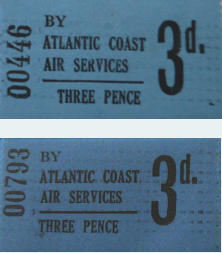
In the second variety found in rolls two and four (501-1000 and 1501-2000)
the T of THREE is now aligned with the text above and the T of THREE is
below the A of AIR.
This is the new value introduced with the second printing. It was
issued in two rolls with the numbers 00001 to 02000.

Second Design. Map Labels 1st April 1936.
The second issue of stamps were much more attractive than the plain first issue. It showed the route the plane would take from Lundy to Barnstaple with some points of interest such as the Town Hall. In this issue there were six values, the 1/2d. black, 1d. red, 2d green, 3d blue, 6d orange and 1/- purple. They were printed in sheets of twelve rouletted between the stamps. There were 1,000 sheets of the 1/2d value printed bound in 10 books. There are two varieties in at least two denominations which will be listed further down the page.Map stamps varieties.
There are two known varieties on the 1/2d, penny and twopenny labels. They are almost certainly on all values as this would appear to be a flaw on the master plate that affects all values. Type a) positional variety is known as the flag variety. Type b) positional variety in known as the ‘stop’ variety and appears 3 times on the 1/2d and 1d labels. 8 of the labels are normal with no variety.Positional varieties of the 1/2d label.
This example shows the ‘stop’ variety. Next to LUNDY
is a full stop. On the 1/2d sheet this occurs 3 times at
R1.2, R2.1, R2.2. See the full sheet below.
This example shows the flag variety. On the right-
hand side of the town hall there appears to be a flag.
This variety appears once on the half penny sheet at
R3.1. On the flag variety there is also a dash below
the e of aerodrome. See the full sheet below.
The positions as listed above can be noted on the full sheet.
Third Design. Second Issue. Plane stamps in red.
On the 31st March, the third issue design of a plane over Lundy was reprinted, this time in red. Again, they were printed in sheets of 48, rouletted between stamps and imperforate on the margins. Redgrove describes these as being printed in bronze. I do not know how he made this error, but as they were issued close to the printing of his book, maybe he had seen a colour trial and not the actual stamps. Unlikely as this sounds it was a totally out of character mistake. 2000 sheets were printed, and complete sheets still exist and come on the market now and again. The two varieties shown above in the purple section are show here in red. For those interested in the varieties a full sheet is shown below.

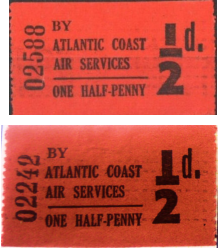


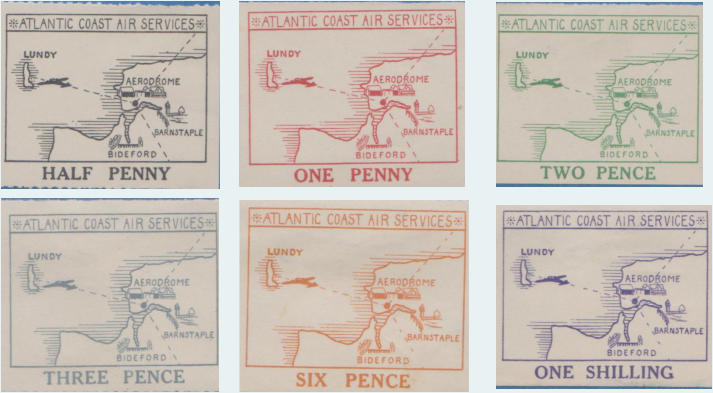

British Internal Airmails of the 1930’s
The second issue of the 3d value was issued in 2 rolls with the
numbers 02001 to 04000. Redgrove identified 2 varieties of this
value. In roll 5 (02001 to 3000) the upper loop of the 3 has a nick at
the top. This can be seen in the example here. In roll 6 (03001 to
04000) the 3 is normal, as can be seen by the second example.
The 1/2d label of the second printing was issued in two rolls with
numbers 4001 to 6000. There are several differences from the first
issue. The BY is smaller, the 1/2d is much larger and the inverted T
where the I and the divider are joined is present. In both these
examples from rolls 1 and 2, there is a stop after the d.
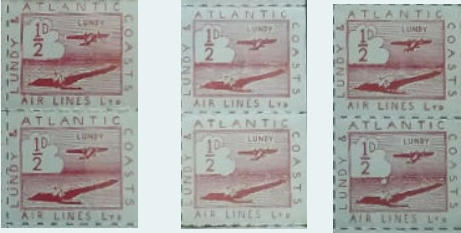




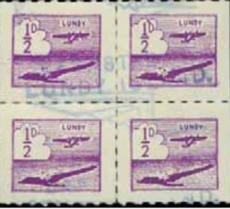

Errors on 1/2d plate.
There were several varieties on the master plate (possibly up to nine). A full description of these is out of the scope of this website and anyone interested in this aspect is recomended to a Lundy stamp catalogue. Two of the more obvious varieties are shown below. They are also shown further down the page in the red printing.
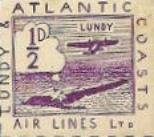
The example to the left has the cloud descending into the sea, instead of flat as
shown in the examples above. The example to the right is the ‘flare’ or ‘sun spot’
variety, where there is a clear white spot beneath the bottom right of the cloud.
In these three examples the top stamp and the leftmost
are normal. The bottom stamp in the middle shows the
cloud in the sea variety and the furthest bottom right
shows the ‘flare’ variety.
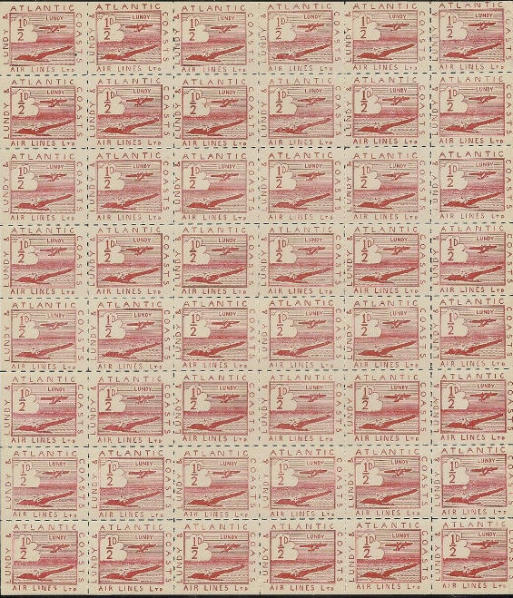
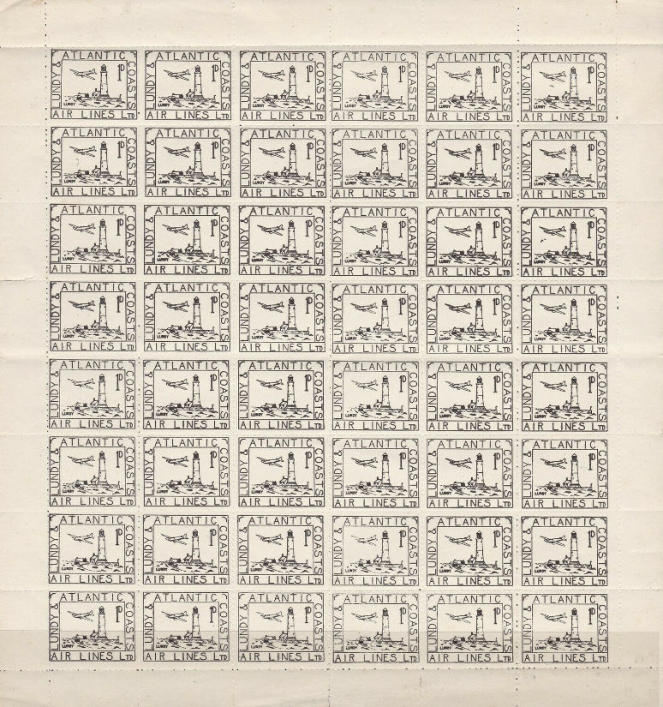
The Bisect Stamp
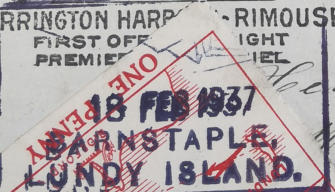
After the large map varieties had been used for a while a new vareity of the 1d
stamp appeared. It was the normal 1d stamp cut in half. These became known as
bisects. Why they were cut in half is not fully understood. It was originally thought
they came about because of a shortage of stamps. It was also thought for a time
they may have been a philatelic ruse to create ‘rarities’. There is another theory that
it may have been because the stamp was large and halfing it saved space. I am not
sure about this as can be seen in the example it does not save much space. These
are scarce but also have been seen in the halfpenny which are even scarcer.
Attantic Error on Five line overprints.
After the 111 sheets (about 5000 stamps) had been over-printed, an error was noticed. In certain positions on the third line of the overprint the ‘l’ of Atlantic was replaced by a ‘t’, making the word ‘Attantic’ rather than ‘Atlantic’. It appeared to occur in about 1 in 10 stamps and the position was always such that the right margin was imperforate. Full details of the error can be found in the Article ‘The Lundy Attantic Error’ by Harold Redgrove.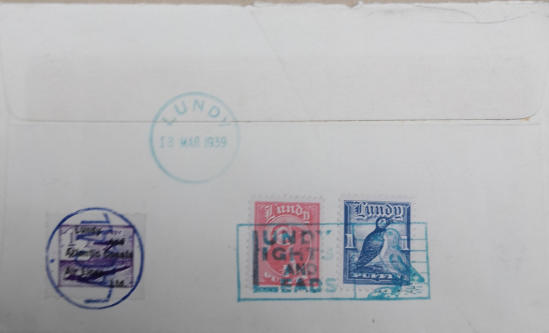
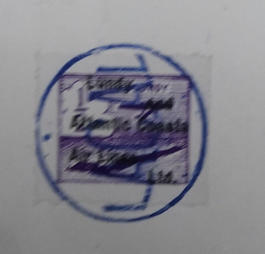

Atlantic Coast Air Services - Air Labels
Third Design. First Issue. Plane stamps in purple.
Redgrove states that from April 1937 there was a shortage of the halfpenny stamp. To ease the shortage prior to printing a new stamp the current 1/2d stamp was cut in half diagonally. Redgrove was told by an American correspondent that this was a Philatelic stunt but Redgrove dismissed this idea. It now appears that there was no shortage of stamps at this time, and it was a philatelic creation to make cachets and postmarks easier to read. They are very scarce, and I do not have one to show. In July 1937, a new 1/2d stamp was issued which was designed by Mr Boyd and showing the Island with a plane in flight, the figure of value 1/2d and the word LUNDY. The stamp was printed in purple in sheets of 48 stamps. The first printing was of 500 sheets but met the objection of Mr Harman who wished the Company name to be included. So, a second issue was printed also of 500 sheets with ‘LUNDY & ATLANTIC COAST AIRLINES’ printed round the edge. Redgrove states that these were issued on the 20th July so the first issue must have been printed earlier. The first printing was never issued and are only found in flown state on Company parcels. They are scarce in both mint and flown form. On 1st November 1938 there was once again a shortage of 1/2d stamps, and 111 sheets of the first printing were overprinted with ‘Lundy Atlantic Coasts Air Lines’ in black. The majority of the first printing sheets were destroyed. If that is somewhat confusing, to summarize. First Printing. Before 20th July 1937 - Only LUNDY on stamp. Note that a number of different proofs were printed which are more common than the production stamps. These proofs are imperforate. The productions stamps whether used or unused are very scarce. Second Printing. 20th July 1937. Company name around stamp. First Printing/Overprint. 1st November 1938. Overprinted in black with the Company name. An example of each type is shown below. As can be seen, the overprint was not consistently positioned.Fourth Design. ‘Lighthouse’ labels. 25th April 1939.
On the 25th April, a new 1d stamp design was issued. It showed a lighthouse with a plane flying past. it was printed in sheets of 48 and 1000 sheets were printed. Like the previous issue it had the name of the company printed around the stamp.
Copyright
© 2020 Robert Farquharson All Rights Reserved
Tram Tickets 2nd Printing. 3rd December 1935.
For the second issue a new value was added - the 1d yellow. All values were printed in rolls of 1000, and there were two rolls of each value. All the values from the second printing are much scarcer used and accoring to Aitchison in the Lundy catlogue only one example is known of the 3d value used within the proper time frame.
In September 1933 Robert Thomas Boyd was on the lookout for a base for his two Gipsy Moths. Barnstaple’s local councillors
had been looking at the possibility of opening an aerodrome but had abandoned the idea due to the cost. Boyd along with a
former RFC pilot Tommy Nash established a landing ground at Heston Court on the Tay Estuary which was officially opened as
the Barnstaple and North Devon Aerodrome on June 13 1934. Boyd had his eye on Lundy Island as a site for a possible
commercial service and he founded Barnstaple and North Devon Air Services in October 1933.
Although initially reluctant the owner of Lundy Island Martin Coles Harmon was persuaded of the potential benefits. The Air Ministry licensed an area on
Lundy Island and Boyd changed the name of the airline to Atlantic Coast Air services in July 1934 and began operating a full-time service to Lundy in April
1935. By the start of WW2 Boyd had flown over 2200 return flights. On 26th April 1937 the firm was formally incorporated as Lundy and Atlantic Coast
Airlines. By now the company had additional routes to Cardiff, Jersey and Plymouth in operation. The company went on flying until 1940 when the RAF
requisitioned their aircraft. After the war was finished services did not start again until 1950 when Devon Air Travel started a service.
Atlantic Coast Air Services flights to Lundy Island.
Lundy Island, in the Bristol Channel, had a post office from 1892 to 1927, when it was closed as they could not get a postmaster. As there was no Post Office monopoly the owner, M.C. Harman, carried mail by sea between the island and the mainland. Lundy issued its own stamps from 1929. From 1935 Atlantic Coast Air Services (later Lundy and Atlantic Coasts Air Lines) carried mail by air to Barnstable. Mr. Harman charged an administrative fee of ½d and the airline a fee of ½d for carrying the mail, and stamps were issued for both fees. The Initial flight took place in Sep 1934 and the regular service started in the spring of 1935. To simplify the bookwork a set of stamps were produced for use on flown mail. Starting with the ‘Tram Tickets’ so called because they were exactly like tram tickets. By April 1936, the service was on a more business-like basis. The Lundy and Atlantic Coast Airlines was formed, and they issued 5 air labels between 1936 and 1939. The Lundy issues of Mr Harman are out of the scope of this website and only information on the air stamps issued byt the airline and their cancels are included here. For information on the Lundy stamps see ‘Stamps and Postal History of Lundy Island. SIxth Edition’ by Jon Aitchison. It is a superb catalogue and at the time of writing (June 2021) was still in print and available from the author.First Design. Tram Tickets 1st Printing. 2nd April 1935.
The first set of labels produced for Atlantic Coast Air Services were the so called ‘Tram tickets’ so named because they looked nothing like normal air labels but like tram tickets. The labels were produced on 2 April 1935 and consisted of a ½d black writing on a red background label and a 3d black writing on a blue background label. The 3d label was provided for use with parcels. Although the GPO has no jurisdiction over Lundy Island, when posting from Lundy Island to the mainland they did put the label on the back of the envelope. This was to prevent any confusion when the envelope or postcard entered the British postal system. SInce the 1980’s a tram ticket register has been used to record all known existing examples of the tickets. The full list of all known examples can be found in the Lundy catalogue. The 1/2d label. The ½ red label was printed in 8 rolls of 500 from 0001 to 4000. The roll 2001 to 2500 has a variety called the inverted T. This is where instead of a gap between the upper ‘1’ of ½ d and the bar, the upper half meets the bar giving an impression of an inverted T. As only one of the eight rolls has this variety, they are much scarcer than the normal type both flown and mint. .
The normal tram ticket label that appeared on seven of the eight rolls, no’s
1-4 (1-2000) and 6-8 (2501-4000), where on the 1/2d value there is a space
between the 1 and the divider.
The inverted T variety only found in roll five of the eight rolls (2001-2500).
The 1 of the 1/2d and the dividing line have merged forming what looks like
an inverted T.
The 3d label. The 3d blue label was issued in 4 rolls (1-2000). There are two varieties. The first variety found in roll 1 (1-500) has the ‘THREE PENCE’ written
value out of alignment with the text above. The T of the THREE appears below the R of AIR. In the second variety found in rolls two and four (501- 1000
and 1501 - 2000) the T of THREE is now aligned with the text above and the T of THREE is below the A of AIR. No examples are known from roll 3 (1001 -
1500). It was probably damaged and discarded but this is not known for certain.
Variety found in roll 1 (1-500) has the ‘THREE PENCE’ written value out of
alignment with the text above. The T of the THREE appears below the R of
AIR.

In the second variety found in rolls two and four (501-1000 and 1501-2000)
the T of THREE is now aligned with the text above and the T of THREE is
below the A of AIR.
Second Design. Map Labels 1st April 1936.
The second issue of stamps were much more attractive than the plain first issue. It showed the route the plane would take from Lundy to Barnstaple with some points of interest such as the Town Hall. In this issue there were six values, the 1/2d. black, 1d. red, 2d green, 3d blue, 6d orange and 1/- purple. They were printed in sheets of twelve rouletted between the stamps. There were 1,000 sheets of the 1/2d value printed bound in 10 books. There are two varieties in at least two denominations which will be listed further down the page.Map stamps varieties.
There are two known varieties on the 1/2d, penny and twopenny labels. They are almost certainly on all values as this would appear to be a flaw on the master plate that affects all values. Type a) positional variety is known as the flag variety. Type b) positional variety in known as the ‘stop’ variety and appears 3 times on the 1/2d and 1d labels. 8 of the labels are normal with no variety.Positional varieties of the 1/2d label.
The positions as listed above can be noted on the full sheet.
Third Design. Second Issue. Plane stamps in red.
On the 31st March, the third issue design of a plane over Lundy was reprinted, this time in red. Again, they were printed in sheets of 48, rouletted between stamps and imperforate on the margins. Redgrove describes these as being printed in bronze. I do not know how he made this error, but as they were issued close to the printing of his book, maybe he had seen a colour trial and not the actual stamps. Unlikely as this sounds it was a totally out of character mistake. 2000 sheets were printed, and complete sheets still exist and come on the market now and again. The two varieties shown above in the purple section are show here in red. For those interested in the varieties a full sheet is shown below.
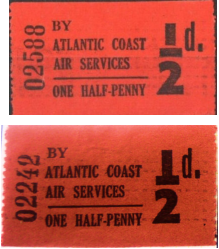




British Internal Airmails of the 1930’s


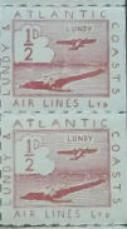









Errors on 1/2d plate.
There were several varieties on the master plate (possibly up to nine). A full description of these is out of the scope of this website and anyone interested in this aspect is recomended to a Lundy stamp catalogue. Two of the more obvious varieties are shown below. They are also shown further down the page in the red printing.

The example to the left has the cloud descending into the sea, instead of flat as
shown in the examples above. The example to the right is the ‘flare’ or ‘sun spot’
variety, where there is a clear white spot beneath the bottom right of the cloud.
































